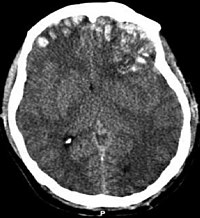
Photo from wikipedia
Background: The authors tested the hypothesis that the effects of traumatic brain injury, surgery, and sevoflurane interact to induce neurobehavioral abnormalities in adult male rats and in their offspring (an… Click to show full abstract
Background: The authors tested the hypothesis that the effects of traumatic brain injury, surgery, and sevoflurane interact to induce neurobehavioral abnormalities in adult male rats and in their offspring (an animal model of intergenerational perioperative neurocognitive disorder). Methods: Sprague-Dawley male rats (assigned generation F0) underwent a traumatic brain injury on postnatal day 60 that involved craniectomy (surgery) under 3% sevoflurane for 40 min followed by 2.1% sevoflurane for 3 h on postnatal days 62, 64, and 66 (injury group). The surgery group had craniectomy without traumatic brain injury, whereas the sevoflurane group had sevoflurane only. On postnatal day 90, F0 males and control females were mated to generate offspring (assigned generation F1). Results: Acutely, F0 injury rats exhibited the greatest increases in serum corticosterone and interleukin-1β and -6, and activation of the hippocampal microglia. Long-term, compared to controls, F0 injury rats had the most exacerbated corticosterone levels at rest (mean ± SD, 2.21 ± 0.64 vs. 7.28 ± 1.95 ng/ml, n = 7 - 8; P < 0.001) and 10 min after restraint (133.12 ± 33.98 vs. 232.83 ± 40.71 ng/ml, n = 7 - 8; P < 0.001), increased interleukin-1β and -6, and reduced expression of hippocampal glucocorticoid receptor (Nr3c1; 0.53 ± 0.08 fold change relative to control, P < 0.001, n = 6) and brain-derived neurotrophic factor genes. They also exhibited greater behavioral deficiencies. Similar abnormalities were evident in their male offspring, whereas F1 females were not affected. The reduced Nr3c1 expression in F1 male, but not female, hippocampus was accompanied by corresponding Nr3c1 promoter hypermethylated CpG sites in F0 spermatozoa and F1 male, but not female, hippocampus. Conclusions: These findings in rats suggest that young adult males with traumatic brain injury are at an increased risk of developing perioperative neurocognitive disorder, as are their unexposed male but not female offspring. Repeated exposures to sevoflurane induced a statistically significant increase in neuroinflammation and stress response alongside decreased neurocognitive performance in 2-month-old male rats with moderate traumatic brain injury when compared to nontraumatized counterparts. Comparable abnormalities were observed in unexposed male but not female offspring of sevoflurane-exposed male rats with traumatic brain injury. These laboratory observations suggest that traumatic brain injury may be a risk factor for developing perioperative neurocognitive disorder and raise the possibility of a sex-specific intergenerational effect of this pathology.
Journal Title: Anesthesiology
Year Published: 2022
Link to full text (if available)
Share on Social Media: Sign Up to like & get
recommendations!